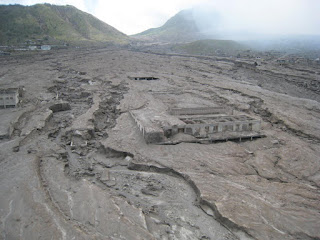




We took a helicopter trip over Montserrat, where there is still an active volcano that continuously vents steam and sulphur, has frequent minor eruptions, and a more significant one about once a month. The last really big eruption was in 1997, following another in ’95, which killed 19 people, and the island was evacuated all but for a few who refused to leave. The airport was mostly covered and the capitol Plymouth was largely buried in ash, both abandoned, and temperatures were high enough to melt glass windows in houses nearby the ash and lava flows.
There now a Safe Zone where some building is going on and there is a new small airstrip. The southern part of the island is an Exclusion Zone where access is strictly controlled and then only in the company of scientists monitoring the volcano activity. The smell of sulphur was immediately evident when we flew in the vicinity of the volcano. The scale of the damage from the flow was awesome, with 5 square miles of extra land created in one area where it flowed over a cliff and into the sea, and long tracts of ash flow rutted by later rain. It was a stunning trip well worth the visit and we saw some turtles sunning themselves on the surface of shallower water near Antigua on the return.
There now a Safe Zone where some building is going on and there is a new small airstrip. The southern part of the island is an Exclusion Zone where access is strictly controlled and then only in the company of scientists monitoring the volcano activity. The smell of sulphur was immediately evident when we flew in the vicinity of the volcano. The scale of the damage from the flow was awesome, with 5 square miles of extra land created in one area where it flowed over a cliff and into the sea, and long tracts of ash flow rutted by later rain. It was a stunning trip well worth the visit and we saw some turtles sunning themselves on the surface of shallower water near Antigua on the return.
No comments:
Post a Comment